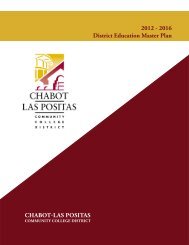City College of San Francisco - California Competes
City College of San Francisco - California Competes
City College of San Francisco - California Competes
You also want an ePaper? Increase the reach of your titles
YUMPU automatically turns print PDFs into web optimized ePapers that Google loves.
THEME IV<br />
Departmental pr<strong>of</strong>ile. The ESL Department is the <strong>College</strong>’s largest, with over 22,000 students and approximately<br />
375 instructors at nine campuses and a hundred smaller sites. Many ESL students enroll to improve<br />
their English in order to be more successful at work, more effective as parents, and more active in their<br />
communities. Still others enroll because they intend to achieve an associate degree or transfer to a baccalaureate<br />
institution.<br />
The ESL curriculum is composed <strong>of</strong> courses in both the noncredit and credit modes, with numerous 10<br />
levels to accommodate students who range from the emerging literate to those who are better prepared<br />
academically, and whose knowledge <strong>of</strong> English ranges from “absolute zero beginning” to advanced. Many<br />
classes integrate the learning <strong>of</strong> speaking, listening, reading, writing, and grammar skills.<br />
In addition to these obvious benefits in terms <strong>of</strong> the breadth <strong>of</strong> <strong>of</strong>ferings, one expects a certain economy<br />
<strong>of</strong> scale in a large department, making it possible to “pool” (as it were) the human and financial resources<br />
in order to pursue high goals. That is certainly true <strong>of</strong> CCSF’s ESL Department. The Department has been<br />
able to maintain its own Noncredit Curriculum Committee, its own Personnel Committee, and various<br />
other working committees. There are not only many very active committees at the department level, but<br />
within the ESL Department, faculty at the various campuses may set up campus curriculum committees<br />
to address issues <strong>of</strong> teaching and learning at their particular campus.<br />
Assessment and learning. Assessment is one <strong>of</strong> these areas in which ESL benefits from economies <strong>of</strong> scale.<br />
The Department has its own Assessment Resource Instructor, who oversees the use <strong>of</strong> standardized tests,<br />
such as those used for placement or for promotion. ESL students need to be tested as they come into the<br />
program to find their English skill level, in order to be placed in the classes that are neither too difficult<br />
nor too easy for them and that will best allow them to learn. Once they are in classes and have nearly<br />
completed a course, they need to be assessed to see if they have met the criteria for course completion<br />
and advancement to a higher level.<br />
Assessment challenge and response. In typical form, given its commitment to excellence and its past<br />
leadership, CCSF was one <strong>of</strong> the first colleges in the state to respond to the State Model Standards by<br />
developing a Noncredit Curriculum Guide based on these standards and began revising the ESL program. 11<br />
Faculty relied upon the Noncredit Curriculum Guide for direction, and at that time ESL was already doing<br />
standardized placement and promotion testing. When the noncredit ESL program was redesigned for<br />
alignment with these standards, the effective promotion testing program had to be scrapped and a new<br />
series <strong>of</strong> tests developed. The redesigned CCSF noncredit ESL program would essentially split each <strong>of</strong><br />
the state model curriculum levels into two, for a total <strong>of</strong> 8-9 levels. For efficiency and alignment with<br />
the state, tests were developed only for even-numbered levels. They were also developed only for the<br />
skills—reading and listening—which could be most easily tested and scored. Although the previous<br />
assessment system had included testing speaking and writing skills at the midpoint <strong>of</strong> the noncredit<br />
ESL program, this provision initially was not carried over into the new assessment system. However,<br />
over the years, faculty increasingly felt that common assessment instruments should be developed for<br />
speaking and writing.<br />
10 For example, 87 noncredit ESL courses are recorded in the State Chancellor’s Office for use at CCSF,<br />
more than twice those <strong>of</strong> any other <strong>California</strong> community college.<br />
11 The Department is currently in the process <strong>of</strong> revising its course outlines to conform with the revised ESL Model Standards<br />
that are forthcoming from the <strong>California</strong> Department <strong>of</strong> Education. In addition, student surveys conducted in Spring 2005<br />
led to innovations such as more weekend classes, and surveys have been conducted in the past few years to identify curricular<br />
objectives for EL Civics-funded classes. In addition, faculty conduct informal assessments in their classrooms to determine<br />
life skill areas that would be especially useful to students.<br />
CITY COLLEGE OF SAN FRANCISCO<br />
305







